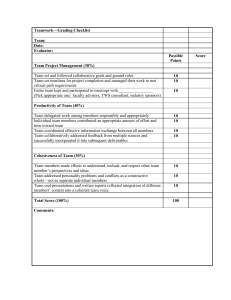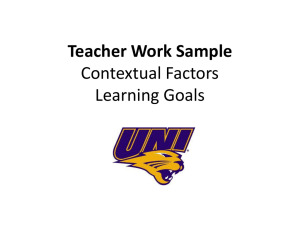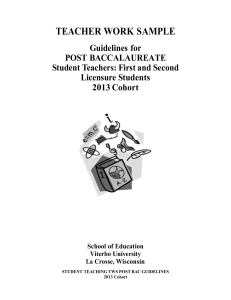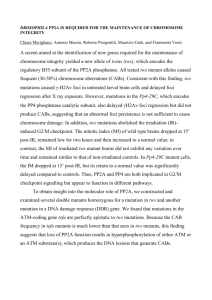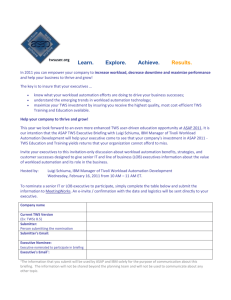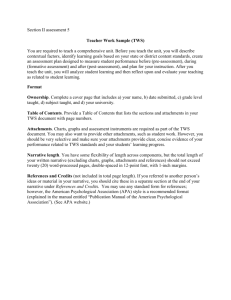Teacher Work Sample - Valdosta State University
advertisement
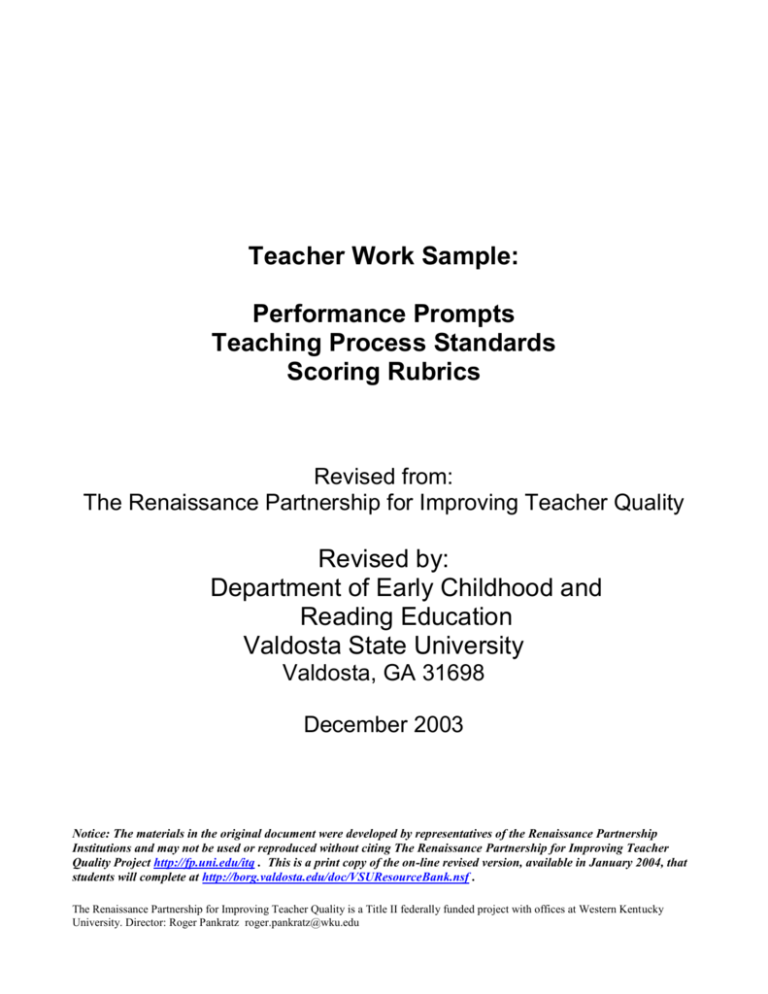
Teacher Work Sample: Performance Prompts Teaching Process Standards Scoring Rubrics Revised from: The Renaissance Partnership for Improving Teacher Quality Revised by: Department of Early Childhood and Reading Education Valdosta State University Valdosta, GA 31698 December 2003 Notice: The materials in the original document were developed by representatives of the Renaissance Partnership Institutions and may not be used or reproduced without citing The Renaissance Partnership for Improving Teacher Quality Project http://fp.uni.edu/itq . This is a print copy of the on-line revised version, available in January 2004, that students will complete at http://borg.valdosta.edu/doc/VSUResourceBank.nsf . The Renaissance Partnership for Improving Teacher Quality is a Title II federally funded project with offices at Western Kentucky University. Director: Roger Pankratz roger.pankratz@wku.edu Overview of Teacher Work Sample (TWS) The Vision Successful teacher candidates support learning by designing a Teacher Work Sample that employs a range of strategies and builds on each student’s strengths, needs, and prior experiences. Through this performance assessment, teacher candidates provide credible evidence of their ability to facilitate learning by meeting the following TWS standards: •The teacher uses information about the learning-teaching context and student individual differences to set learning goals and plan instruction and assessment. •The teacher sets significant, challenging, varied, and appropriate learning goals. •The teacher uses multiple assessment modes and approaches aligned with learning goals to assess student learning before, during, and after instruction. •The teacher designs instruction for specific learning goals, student characteristics and needs, and learning contexts. •The teacher uses regular and systematic evaluations of student learning to make instructional decisions. The teacher uses assessment data to profile student learning and communicate information about student progress and achievement. •The teacher reflects on his or her instruction and student learning in order to improve teaching practice. Your Assignment The TWS contains six teaching processes identified by research and best practice as fundamental to improving student learning. Each Teaching Process is followed by a TWS Standard, the Task, a Prompt, and a Rubric that defines various levels of performance on the standard. The Standards and Rubrics will be used to evaluate your TWS. The Prompts (or directions) help you document the extent to which you have met each the standard. You are required to teach a comprehensive unit. Before you teach the unit, you will describe contextual factors, identify learning goals based on your state content standards, create an assessment plan designed to measure student performance before (pre-assessment), during (formative assessment) and after (post-assessment), and plan for your instruction. After you teach the unit, you will analyze student learning and then reflect upon and evaluate your teaching as related to student learning. Format •Ownership. Complete a cover page online that includes (a) your name, (b) date submitted, (c) grade level taught, (d) subject taught, (e) course number and title. •Charts, graphs and attachments. Charts, graphs and assessment instruments are required as part of the TWS document. You may also want to provide other attachments, such as student work. However, you should be very selective and make sure your attachments provide clear, concise evidence of your performance related to TWS standards and your students’ learning progress. •References and Credits. If you referred to another person’s ideas or material in your narrative, you should cite these in a separate section at the end of your narrative under References and Credits. The American Psychological Association (APA) style is the required format (explained in the manual entitled, Publication Manual of the American Psychological Association). •Anonymity. In order to insure the anonymity of students in your class, do not include any student names or identification in any part of your TWS. 2 Teaching Processes Assessed by the Revised Renaissance Teacher Work Sample Teaching Processes, TWS Standards, and Indicators I. Contextual Factors The teacher uses information about the learning-teaching context and student individual differences to set learning goals and plan instruction and assessment. Knowledge of community, school, and classroom factors Knowledge of characteristics of students Knowledge of students’ varied approaches to learning Knowledge of students’ skills and prior learning Implications for instructional planning and assessment II. Learning Goals and Assessment Plan The teacher sets significant, challenging, varied and appropriate learning goals and uses multiple assessment modes and approaches aligned with learning goals to assess student learning before, during and after instruction. Significance, Challenge and Variety Clarity Appropriateness for students Alignment with national, state or local standards Clarity of criteria for performance Multiple modes and approaches Technical soundness Adaptations based on the individual needs of students III. Design for Instruction The teacher designs instruction for specific learning goals, student characteristics and needs, and learning contexts. Alignment with learning goals Accurate representation of content Lesson and unit structure Use of a variety of instruction, activities, assignments and resources Use of contextual information and data to select appropriate and relevant activities, assignments and resources. Use of technology IV. Analysis of Student Learning The teacher uses regular and systematic evaluations of student learning to make instructional decisions. The teacher uses assessment data to profile student learning and communicate information about student progress and achievement. Clarity and accuracy of presentation Alignment with learning goals Interpretation of data Evidence of impact on student learning V. Reflection and Self-Evaluation The teacher reflects on his or her instruction and student learning in order to improve teaching practice. Interpretation of student learning Insights on effective instruction and assessment Implications for future teaching 3 I. Contextual Factors TWS Standard The teacher uses information about the learning-teaching context and student individual differences to set learning goals and plan instruction and assessment. Task Discuss relevant factors and how they may affect the teaching-learning process. Include any supports and challenges that affect instruction and student learning. Prompt Community, School System, and School Factors Geographic Location Rural/ Urban List unique features of community List contributions of community to school School System Name of school system Number of students in school system Number of students in school system on free or reduced lunch School Name of school Grades served Student enrollment Classroom Characteristics Students Boys/Girls, Age range, Ethnicity (give numbers) Socio-Economic Profile (% Students in classroom on free or reduced lunch) Reading Achievement (% Above-average or advanced / % Average or intermediate / %Below average) Based on: Mathematics Achievement (% Above-average or advanced / % Average or intermediate / % Below average) Based on: Classroom Organization Homogeneous/ Heterogeneous/Self-Contained/Team Teaching/Departmentalized/Parallel Block/Other programs Resources (Television, Classroom library, Number of computers in classroom) List other resources (such as math and science manipulative materials) Parental Involvement (Parent classroom volunteers; Classroom newsletter, Family-student interactive learning kits; Classroom website; School website) Individual Differences Students Attending Pull-Out or Supplementary Programs (number in Title I Reading, Gifted, Early Intervention Program, Safety Net; List other programs) Language Proficiency (number: English Language, Bilingual, Other Language) Students with Individual Education Plans (IEP) (number Blind or visually impaired; Deaf or hearing impaired; Developmentally delayed; Emotionally or behaviorally disordered; Learning disabled; Physically disabled; Other) Students’ Previous Learning on the Subject of Your Unit Instructional Implications Using the information you have collected above, address how the contextual characteristics of the community, school, classroom, and students have implications for your instructional planning and assessment. Address specifically how these contextual factors will impact your unit. Include information about students’ previous learning on the subject of your unit and how their previous learning will impact your unit. 4 II. Learning Goals and Assessment Plan TWS Standard The teacher sets significant, challenging, varied, and appropriate learning goals. Task Provide the learning goals for the unit. Prompt I. List the topic. II. Identify the main content area. The content area for the Teacher Work Sample must be language arts, math, science, or social studies. Other content areas that are incorporated into the lessons are to be included on the Lesson Plan Guide. III. List the learning goals (not the activities) that will guide the planning, delivery, and assessment of your unit. These goals should define what you expect students to know and be able to do at the end of the unit. The goals should be significant, challenging, varied, and appropriate. Number each learning goal so you can reference it later. Develop a minimum of two and a maximum of six learning goals for you unit. IV. List the primary learning outcomes under each learning goal. A learning outcome is a general term that is used to replace “learning objective” and states more specifically what students should know and be able to do in observable and measurable terms. These outcomes are to be the same as those on the daily lesson plans. A. List the Georgia QCC Standards that are aligned with each learning goal. B. Pre/Post Assessment Plan. For each learning goal include: a description of the format of each assessment task, the criterion you will use to determine if the students’ performance meets the learning goal, adaptations of the assessment tasks you will make based on the needs of individual students or contextual factors. C. Include a copy of the pre/post assessment, prompts, and/or student directions (e.g., scoring rubrics, observation checklist, rating scales, item weights, test blueprint, answer key). Type the corresponding learning goal next to each item or section on the attached copy of your pre/post assessment instrument. 5 III. Design for Instruction TWS Standard The teacher designs instruction for specific learning goals, student characteristics and needs, and learning contexts. Task Describe how you will design your instruction related to unit goals, students’ characteristics and needs, and the specific learning context. Prompt •Analysis of pre-assessment results. After administering the pre-assessment, analyze student performance relative to the learning goals. Depict the results of the pre-assessment using a table and graph that allows you to find patterns of student performance relative to each learning goal. Describe the information you find that will guide your instruction or modification of the learning goals. •Lesson plan guide. Write a lesson plan for each lesson to be taught in the Teacher Work Sample. Follow the format given below. Lesson Plan Guidelines General Information Title of Lesson: Date Taught: Total Duration of Lesson: Primary Learning Outcome(s) (PLO) State the observable concept or measurable skill the student will demonstrate as an outcome of participation in the lesson. Write each primary learning outcome as a statement. Place a letter beside each outcome (i.e., A., B., C.). List the essential questions related to each primary learning outcome. (Optional unless required by the course instructor) Note: Each PLO must be taught, practiced, and assessed during the lesson. Related QCC Standard(s) Identify one or two QCC standard(s) closely aligned to each primary learning outcome. Note: Do not include additional learning outcomes or non-assessed QCC Standards. Materials and Equipment Provide a list of all materials and equipment that you will need as you teach, practice, and assess each PLO. Write all references using the correct APA 5th edition format. If modifying a lesson from the Internet or another source, provide a copy of the original lesson. Include copies of anything you give to students, sketches of materials you prepare, examples/models you show to students, and copies of transparencies used. 6 Technology Connection (Must be included when appropriate for the lesson and/or required by the course instructor.) Include a component for technology enhancement by describing an appropriate computer-based activity or including the use of an Internet resource(s). Describe the computer-based activity. Provide the information below for the Internet resource(s): Title: (List the title of the web site.) URL: (Copy and paste the URL here.) Procedures Note: Give enough information so that someone else could teach this lesson using your plan. Provide evidence that students are involved in each step of the procedures. Step One: Introduction Explain how you will integrate the following: Spark the students’ interest and excitement about new learning. Tell the students what they will be learning (primary learning outcomes) and doing (orally, in writing, or both). State the importance of the lesson to the students’ lives today and/or future learning of similar content. Establish a connection to the students’ prior knowledge and/or personal experiences. List questions you may ask the students. Estimated Time: (Give an estimate of the time it will take to complete this step.) Step Two: Teaching the Primary Learning Outcome(s). Note: For longer and/or more complex lessons, teaching, checking for understanding, and/or providing practice may be broken into segments that address each PLO. 1. Teach the content relevant to the primary learning outcome(s). You may choose any of the following: Give an explanation, explain the process, and/or define terms. Demonstrate or model the process of doing at least part of the project to be completed during the lesson. You will be orally rehearsing your thinking processes during this time. Students will be listeners and/or observers. Provide examples or models of the completed project to be completed during the lesson. Explain how your example meets your expectations for the completed project. List questions you will ask the students. 2. Check for understanding before going on. You may choose any of the following: To check some or all students individually, you may ask questions that require a written response, a whispered response, or a signaled response. To check the whole group, you may ask questions that require a choral response, a written response, or a signaled response. List questions you will ask the students. 7 3. Provide practice and feedback related to the primary learning outcome(s). You may choose to have guided practice only, independent practice only, or both guided and independent practice. Label each type of practice as guided practice and/or independent practice. Describe the practice activity/activities you will have students do. List questions you may ask the students. Estimated Time: (Give an estimate of the time it will take to complete this step.) Step Three: Closure Explain how you will integrate the following: Summarize the PLO(s). Review the important concepts, skills, and essential questions. Help students to transfer the new knowledge or skills to future learning. Make connections to students’ lives. List questions you may ask the students. Estimated Time: (Give an estimate of the time it will take to complete this step.) Assessing the Primary Learning Outcome Use letters for each assessment that correspond to the letters used to identify PLO(s). Describe the evidence the student will provide to document achievement of each PLO. Explain how you will assess and record this evidence for each PLO for each student. Identify the step(s) in the procedures in which the assessment will be done. Note: Attach a copy of any written assessment technique(s) used by the teacher or students (e.g. graphic organizer, data chart, test, quiz, or other print resource). Extension (Optional unless required by the course instructor) (How can the content of the lesson be modified to work with students who already understand the concepts taught? Describe that here.) Remediation (Optional unless required by the course instructor) (For students who do not readily grasp concepts, how can the content of the lesson be taught differently? Describe that here.) Accommodation (Optional unless required by the course instructor) (How can the content of this lesson be taught differently for students with exceptional needs? These students will be working on the same primary learning outcome as the lesson. Describe that here.) 8 IV. Analysis of Student Learning TWS Standard The teacher uses assessment data to profile student learning and communicate information about student progress and achievement. Task Use visual representations to communicate the performance of the whole class and two subgroups. Analyze your assessment data, including pre/post assessments and formative assessments, to determine students’ progress related to the unit’s learning goals. Use visual representations and narrative to communicate the performance of the whole class and two subgroups. (Conclusions drawn from this analysis should be provided in the “Reflection and Self-Evaluation” section.) Prompt In this section, you will analyze data to explain progress and achievement toward learning goals. On-Going Formative Assessment Adjustments. Discuss the modifications made during your instruction as a result of what you learned through your on-going formative assessments. Graphic representations are not necessary for this subsection. Pre/Post Assessment Whole class. Create a table that shows pre- and post-assessment data on every student on every learning goal. Then create a bar graph that shows the extent to which your students made progress (from pre- to post-) toward the criterion for each learning goal (identified in your Assessment Plan section). Briefly analyze your results for one learning goal. Subgroups. Select a group characteristic (e.g., gender, performance level, socio-economic status, language proficiency). Create a graphic representation that compares pre- and post-assessment results for the subgroups on one learning goal. Briefly analyze your results. 9 V. Reflection and Self-Evaluation TWS Standard The teacher analyzes the relationship between his or her instruction and student learning in order to improve teaching practice. Task Reflect on your performance as a teacher and link your performance to student learning results. Evaluate your performance and identify future actions for improved practice and professional growth. Prompt Based on the results you obtained and your experience teaching this instructional unit, what will you do differently in planning, teaching, and/or assessment the next time you teach this content? Please be specific. 10

